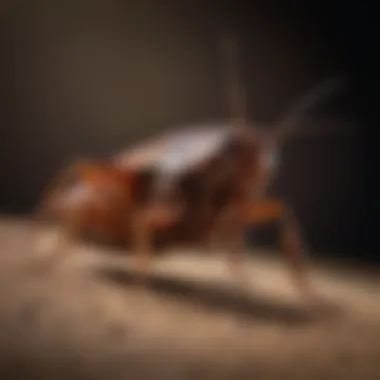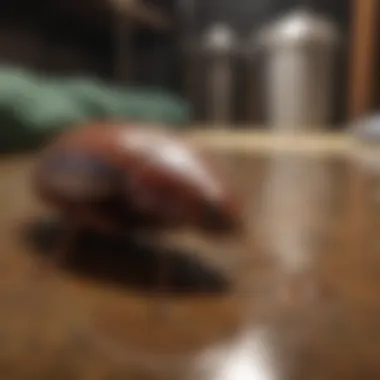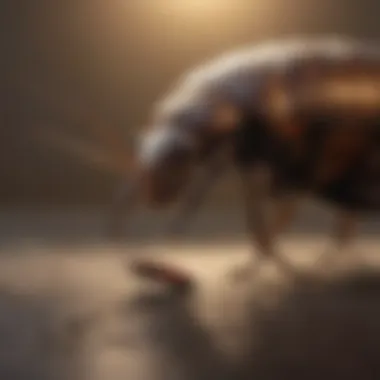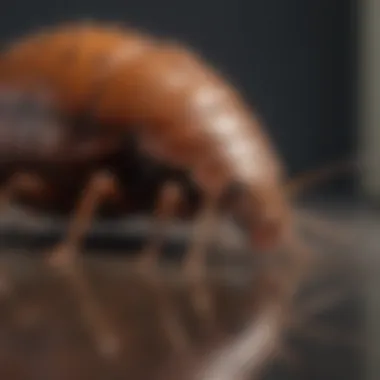Strategies for Effective Cockroach Eradication


Intro
Cockroaches are pervasive pests that can invade both homes and businesses. Their ability to adapt and thrive in various environments makes them difficult to eradicate. This article aims to provide a comprehensive overview of the challenges associated with eliminating cockroaches, highlighting the biological factors that contribute to their resilience and the strategies that can help in their control.
Understanding Pests
Definition of Pests
In a broad sense, pests are organisms that can cause damage to humans, their property, or their food supplies. This includes insects, rodents, and other unwanted wildlife. Specifically, the cockroach is classified as a pest due to its association with unhygienic conditions and its role in spreading diseases.
Importance of Pest Identification
Correctly identifying pests is crucial in managing infestations effectively. Cockroaches come in various species, each exhibiting different behaviors and habitats. For instance, the German cockroach thrives in kitchens and bathrooms, while the American cockroach prefers warm, dark places. Understanding these distinctions allows homeowners to tailor their approach to pest control appropriately.
Prevention Techniques
Home and Garden Preventative Measures
Proactive measures can significantly reduce the chances of a cockroach infestation. Homeowners should consider the following:
- Seal cracks and crevices in walls and foundations.
- Keep food in airtight containers to avoid attracting pests.
- Regularly dispose of garbage and clean any food residues promptly.
In gardens, it is advisable to manage water accumulation and keep plant debris clear to deter roaches from breeding.
Seasonal Prevention Tips
Cockroaches are more active during warmer months. To minimize the risk of infestation, homeowners can adopt seasonal strategies:
- Conduct thorough inspections of indoor and outdoor areas as temperatures rise.
- Ensure all windows and doors are tightly sealed.
- Keep external spaces, like porches, clean and free of clutter.
Eco-Friendly Pest Control Solutions
Overview of Sustainable Practices
In recent years, there has been a shift towards using eco-friendly methods for pest control. These sustainable practices focus on reducing or eliminating the use of harsh chemicals. Techniques such as traps, diatomaceous earth, and essential oils have gained popularity in managing cockroach populations.
Natural Remedies and Their Effectiveness
While chemical extermination may prove effective, natural remedies can also help control cockroach numbers. Many homeowners find success with:
- Boric acid: A natural insecticide that can be used around areas where cockroaches are likely to hide.
- Baking soda: When mixed with sugar, it can entice cockroaches and then kill them when ingested.
- Essential oils: Such as peppermint and tea tree oil, have shown some efficacy in repelling cockroaches.
"Proper sanitation and awareness of potential cockroach habitats are often the most effective ways to prevent infestations."
Understanding Cockroaches
Understanding cockroaches is a crucial step in evaluating the feasibility of eradicating them. This entails not just recognizing their presence but comprehending their biology, common species, and the lifecycle they undergo.
By delving into these elements, homeowners and housewives will gain a deeper insight into the factors that contribute to cockroach infestations. Knowledge about cockroaches helps individuals identify risks, implement preventative measures, and choose the right tactics for eradication.
Furthermore, understanding their behavior allows for more effective strategies tailored to disrupt their habits and hinder their reproduction. This understanding is beneficial in making informed decisions which not only address immediate problems but also curtail future invasions.
Biology of Cockroaches
Cockroaches belong to the order Blattodea. They are resilient creatures, adapted to thrive in various environments. Their bodies are flat, and this distinctive shape allows them to hide in narrow cracks and crevices. Cockroaches have long antennae that serve as sensory organs, assisting in navigation and the detection of chemical cues.
Internally, they possess a simple digestive system, and their diet is diverse, ranging from decaying organic matter to food residues found in human habitations. This adaptability in feeding contributes to their survival in urban settings, which can often sustain large populations. Additionally, cockroaches exhibit a unique defense mechanism; they can survive without food for weeks, though they require water more frequently.
Common Species of Cockroaches
Among the numerous species, several are predominant in households. The German cockroach is notorious for its rapid reproduction and ability to thrive in kitchens. In the US, the American cockroach can also be found. This species is larger and can fly, making it more challenging to control. The Oriental cockroach prefers cooler areas and is less active compared to others.


Each species has distinct behaviors and habitats, influencing how one might approach their eradication. Understanding these differences is crucial for selecting appropriate treatment strategies.
Life Cycle and Reproduction
Cockroaches undergo a lifecycle that includes three main stages: egg, nymph, and adult. The female cockroach produces an ootheca, which holds multiple eggs. Depending on the species, the number of eggs in a case can range significantly.
Upon hatching, nymphs emerge and resemble miniatures of the adults. They require several molts before reaching maturity. The full maturation can take anywhere from a couple of months to a year based on environmental conditions.
This rapid reproduction creates an alarming possibility of large populations establishing in a short time. Therefore, comprehending this lifecycle is vital for effective pest control and prevention strategies.
"Control efforts must consider both the biology and behavior of cockroaches for successful outcomes."
In summary, grasping the essentials of cockroaches— their biology, common species, and lifecycle— empowers homeowners to formulate more effective pest management strategies. Understanding these aspects is not merely academic; it fundamentally underpins any successful approach to eradicating these pervasive pests.
Challenges of Cockroach Eradication
Cockroaches present a significant challenge to anyone seeking effective eradication. Understanding these challenges is crucial for developing successful strategies. The complexity of their biology, rapid reproduction, and behavioral adaptations makes eradication a daunting task. Families and home owners must approach this issue with a clear understanding of what they are up against.
Resistance to Insecticides
Cockroaches have developed a remarkable resistance to various insecticides. This resistance is often due to genetic mutation and selective pressure from overuse of certain chemicals. Many home owners might apply these products with the hope of elimination, but this may only lead to temporary relief. As cockroaches survive exposure, they reproduce and pass these resistant traits onto their offspring.
Some commonly used insecticides include pyrethroids and organophosphates. However, repeated and indiscriminate use can result in diminished effectiveness over time.
- Key Points Regarding Resistance:
- Understanding The chemical properties of common insecticides
- Impact of repeated exposure on cockroach populations
- Need for integrated pest management strategies
"Understanding the biology of cockroaches informs us that some chemical products might render their original purpose ineffective over time."
Rapid Reproduction Rates
The ability of cockroaches to reproduce quickly is a major hurdle in eradication efforts. Female cockroaches can produce several egg cases in their lifetime, with each case containing dozens of eggs. It is not uncommon for one female to lead to hundreds or thousands of progeny within a short period. This rapid life cycle makes traditional extermination methods ineffective if not timed correctly.
- Points to Consider:
- Lifespan of cockroaches can be up to two years
- Potential for exponential growth in a short time frame
- Importance of early intervention and consistent monitoring
Behavioral Adaptations
Cockroaches have developed unique behaviors that help them evade capture and chemical treatments. For instance, they are primarily nocturnal, which allows them to avoid detection and treatment efforts during the day. Their ability to squeeze through tiny crevices and their keen sensitivity to environmental changes make it challenging to target them effectively.
- Considerations for Effective Handling:
- Understanding cockroach habits and hiding places
- Implementing multiple strategies for eradication
- Continuing education on pest behavior for homeowners
Assessment of Eradication Methods
Evaluating the eradication methods for cockroaches is pivotal in understanding how to effectively manage infestations in both residential and commercial spaces. Different approaches exist, each with their unique features and efficacy. The choice of method can greatly influence not only immediate outcomes but also the long-term success of pest management strategies.
By analyzing various methods, property owners can align their pest control strategies with their specific circumstances, while also making informed decisions that consider health, cost, and ecological impact.
Chemical Solutions
Chemical solutions for cockroach eradication often involve insecticides designed to eliminate pest populations. These substances can be categorized into contact insecticides, which kill on contact, and stomach insecticides, which are ingested. Popular products include Advion Cockroach Gel and Raid Ant and Roach Killer. The benefits of chemical solutions are apparent, as they tend to provide faster results and can cover larger areas efficiently. However, it is essential to consider the potential drawbacks.
- Health Risks: Insecticides can pose health risks to humans and pets. Proper precautions are necessary.
- Resistance: Prolonged use may lead to resistance in cockroach populations.
- Environmental Impact: There may also be adverse effects on non-target species and local ecosystems.
Careful application and adherence to guidelines can mitigate these risks. Always consult product labels and, if needed, pest control professionals for safe use.
Baiting and Trapping
Baiting and trapping methods present alternative solutions that can effectively reduce cockroach populations without the broad application of chemicals. Baits often contain attractants paired with an insecticide that allows cockroaches to consume the bait and return to their harborage sites, where they ultimately die. Products like Combat Max 12-Month Roach Killing Bait are frequently chosen for their effectiveness.


Traps, such as sticky traps, serve as a non-toxic option for monitoring and capturing cockroaches. Their ease of use makes them accessible for many homeowners.
- Key Advantages:
- Focused action on targets
- Usually less toxic to humans and pets compared to traditional insecticides
- Good for monitoring infestation levels
However, there are considerations to keep in mind. Baiting requires patience since results may take time to manifest. Moreover, proper placement of baits and traps is crucial to maximize effectiveness.
Natural Remedies
Natural remedies are gaining popularity among those seeking environmentally-friendly pest control methods. Some homeowners prefer to utilize substances such as diatomaceous earth, essential oils like peppermint or tea tree oil, and even soap solutions to repel or kill cockroaches.
Natural methods have various benefits:
- Safety: Generally considered safer for households with children and pets.
- Sustainability: Lower impact on the environment.
- Accessibility: Many ingredients can be sourced easily from local stores or made at home.
However, the effectiveness of these remedies can vary significantly. They may not provide the same level of instant results as chemical options, and some users may find that a combination of methods yields the best results. If opting for natural remedies, it's crucial to conduct thorough research on the most effective combinations and application techniques.
"Eradicating cockroaches effectively often requires a multi-faceted approach."
Overall, understanding the various methods of cockroach eradication is foundational in creating an effective pest management plan. It allows homeowners and property managers to select the right tools, consider their specific needs, and integrate multiple strategies to achieve long-lasting results.
Preventative Measures
Preventative measures are critical in the ongoing fight against cockroach infestations. Understanding the nature of cockroaches and their habits allows homeowners to take significant steps in limiting their presence. By implementing these measures, the likelihood of a severe infestation can be decreased, which ultimately saves time and money on potential extermination efforts.
Sanitation Practices
Proper sanitation is the first line of defense against cockroaches. These pests thrive in dirty environments where food and waste are plentiful. Keeping indoor spaces clean not only involves regular sweeping and mopping but also addressing areas that may be overlooked, such as under appliances and furniture.
- Remove food debris promptly after meals.
- Store food in sealed containers to prevent access.
- Dispose of garbage regularly and use tightly closed bins.
- Ensure that pet food is not left out overnight.
- Regularly clean food preparation surfaces.
By instituting rigorous sanitation practices, homeowners can greatly reduce the resources that attract cockroaches, thus making the living environment less inviting for them.
Sealing Entry Points
Cockroaches are small and can enter through very narrow spaces. Sealing entry points prevents new infestations from taking hold. Areas to inspect include:
- Gaps between walls and floors.
- Openings around plumbing and utility lines.
- Cracks in windows and doors.
- Vents and chimneys that may not be securely closed.
Using materials like silicone caulk or foam sealant can effectively block these access points. This not only helps keep cockroaches out but also protects against other pests. Regular inspections are advisable to ensure these seals remain intact over time.
Management of Food Sources
Food management is another essential factor in preventing cockroach infestations. Cockroaches are driven by their basic need for sustenance. Managing food sources involves more than just cleanup:
- Make sure to refrigerate perishables promptly.
- Eliminate standing water, which can be a food source for cockroaches.
- Regularly check pantries and cupboards for any spillage.
- Keep sinks and countertops free of food particles.
- Use pest-proof containers for dry goods to avoid contamination.
By carefully managing these factors, homeowners can significantly reduce the appeal of their spaces to cockroaches.
"Prevention is always better than cure." This old saying rings true, especially in pest control, where small efforts in cleanliness can prevent larger issues down the road.
Professional Pest Control Services
The role of professional pest control services cannot be understated in the context of eradicating cockroaches. These services offer expertise that extends beyond simple application of insecticides. Their knowledge of local pest behavior, environmental factors, and various treatment methods proves invaluable in the ongoing battle against cockroach infestations.
By involving experts, homeowners benefit from a comprehensive approach. While DIY methods may seem effective initially, they lack the depth and precision that professionals can provide. Many individuals may not be aware of the intricacies involved in pest control, such as the specific life cycles of different cockroach species and effective strategies to combat them.
Evaluating Pest Control Options
When considering pest control options, it is essential to evaluate multiple criteria. First, understand the different treatment methods available. These can range from chemical treatments to non-chemical strategies. It is advisable to question the effectiveness of each and to consider their specific context. For instance, methods that work in commercial spaces may not necessarily be applicable in residential settings.


Additionally, leveraging online reviews and testimonials can aid in making an informed decision. Websites like Reddit or Facebook may provide discussions and opinions on local services. This grassroots feedback often reflects the experiences of real customers, guiding better decision-making.
Costs Involved in Professional Treatments
Costs related to professional pest control services can vary widely based on several factors. On average, homeowners might expect to pay between $100 to $300 for initial consultations and treatments. Following treatments, occasional maintenance might be necessary, incurring additional costs.
- Factors Influencing Costs:
- The size of the property
- The severity of the infestation
- Geographical location
- Treatment method selected
Understanding these costs in advance can help budget effectively and avoid unexpected expenses later on.
Advantages of Hiring Professionals
The advantages of hiring professionals cannot be ignored. One significant factor is the level of safety. Professionals use equipment and chemicals that may be too hazardous for untrained individuals. Moreover, they can effectively identify problem areas within the home that may go unnoticed by the average homeowner.
"Hiring professionals not only addresses the immediate problem effectively but also legislates against future infestations through knowledge and preventive measures."
Also, their use of integrated pest management strategies ensures that the pest control process considers long-term prevention, rather than one-off extermination. This holistic approach can greatly reduce the likelihood of re-infestation and thereby reassure homeowners that their environment remains secure and pest-free.
In summary, as homeowners weigh their options regarding cockroach eradication, professional pest control services emerge as a compelling choice. They amalgamate expertise, safety, and effective strategies to ensure that the solution is efficient and sustainable.
Long-term Solutions
Long-term solutions for cockroach eradication are essential in ensuring lasting impacts against these pests. With a thorough approach, individuals can build an enduring defense against cockroach infestations in their homes and businesses. The integration of effective prevention strategies, consistent monitoring, and community involvement is pivotal in not only eliminating cockroaches but also in preventing future outbreaks.
Integrating Prevention and Treatment
To effectively manage cockroach populations, integrating prevention with treatment methods is critical. This involves a holistic approach that combines sanitation efforts, regular inspections, and targeted pest control measures. Here are some steps to ensure that both aspects work cohesively:
- Routine Cleaning: Regularly cleaning food preparation areas and disposing of waste correctly helps deny cockroaches food sources.
- Application of Treatments: Use insecticides or baits strategically after recognizing areas of activity. Treatment should not be a one-time effort but integrated into your regular maintenance routine.
- Long-term Chemical Solutions: Select the right chemicals that target cockroaches specifically. These chemicals need to be deployed in a way that is safe for residents while still effective against the pests.
The key benefit of this integrated strategy is that it enables homeowners to minimize the risk of reinfestation while effectively dealing with current populations.
Monitoring for Future Infestations
Ongoing monitoring is crucial to maintaining a cockroach-free environment. It involves regularly checking areas that are prone to infestations. Effective monitoring practices can include:
- Regular Inspections: Schedule visual assessments of suspected areas, such as kitchens, bathrooms, and basements.
- Use of Monitoring Tools: Employ sticky traps and other monitoring devices to detect early signs of cockroach activity.
- Assessment of Previous Treatments: Review the effectiveness of prior pest control methods to inform future strategies.
Consistent monitoring allows for earlier detection of potential infestations, making it easier to implement responsive measures before populations grow.
Community Strategies for Pest Control
Community involvement plays a significant role in pest management. A united front can considerably amplify the effectiveness of individual efforts. Community strategies may include:
- Awareness Programs: Engaging the community can raise awareness about sanitation practices and the importance of pest control.
- Cooperative Pest Control Initiatives: Neighboring properties can collaborate to implement pest control measures, ensuring a broader reach.
- Policies and Regulations: Local governments can develop policies promoting best practices, making long-term pest control a community priority.
Investing in communal strategies not only increases awareness but also fosters a collective sense of responsibility towards maintaining a pest-free environment. When communities work together, they significantly enhance the chance of successful cockroach eradication.
Epilogue
The conclusion of this article holds significant relevance as it encapsulates the various facets of cockroach eradication discussed throughout. It emphasizes the underlying complexity of managing these pests, showcasing the interplay between biology, behavior, and eradication strategies. The major takeaway is that a holistic approach is vital—individual methods may yield temporary results, but sustainable eradication requires an integrated plan that considers long-term prevention and monitoring strategies.
Moreover, the conclusion serves to remind readers of the necessity of proper sanitation and preventive practices. It underscores how understanding the cockroach’s life cycle and habits can inform better management and control methods. Ignoring these aspects may lead to ineffective measures and further infestation.
In addition, a thoughtful evaluation of professional pest control services is encouraged. Homeowners should consider their options carefully, weighing costs against the potential effectiveness of treatments provided by specialists.
In summary, the conclusion synthesizes the article's insights while reinforcing the need for continuous research and community involvement in pest control strategies. It serves as a call to action, inspiring homeowners and managers alike to be proactive rather than reactive in their approach to pest management.
Summary of Key Insights
- Complexity of Eradication: Successfully eliminating cockroaches involves multiple strategies, including chemical treatments, natural remedies, and preventive measures.
- Biological Understanding: Knowledge of cockroach behavior and biology aids in identifying effective methods for eradication and prevention.
- Community Approach: Collaboration within communities can enhance public health efforts against infestations, emphasizing shared strategies.
- Professional Help: Evaluating and possibly involving professional pest control can provide better long-term outcomes.
- Future Considerations: Continuous research into cockroach behavior and resistance patterns will be essential for developing innovative solutions.
Future Research Directions
Further studies are necessary to address critical challenges in eradicating cockroaches. Potential research directions include:
- Resilience Studies: Investigating the evolution of resistance to various insecticides could inform the development of new compounds or techniques.
- Impact of Environment: Understanding how different environmental factors influence cockroach populations can lead to more targeted prevention strategies.
- Behavioral Analysis: Research into the behavioral patterns of cockroaches in urban settings can help in designing better traps and baits.
- Community Engagement: Evaluating the effectiveness of community-led pest control initiatives can provide insights into collaborative eradication strategies.
- Integrative Methods: Exploring the efficacy of combining chemical, biological, and cultural controls into cohesive programs will be vital for future pest management efforts.



